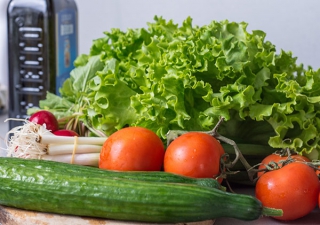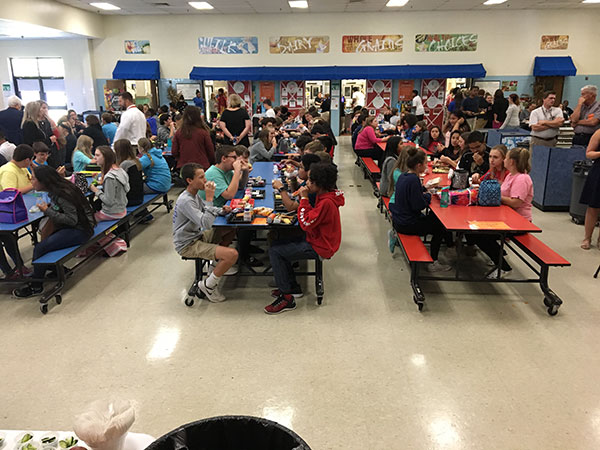
Farm to School Event Connects People of All Ages Through Food Cycle Education
31 October 2017Maryland county school system connects students from elementary to high school, farmers to cooks, chefs to consumers in food cycle education.
By Lisa Parrish, GMC Editor
 Food can educate and ultimately connect people in ways that can only be accomplished over a plate of delicious nourishment. And peoples’ connections with each other only tighten as they share their foodservice link, be it farmer, waterman, cook or consumer. So why not start the connection process in middle school?
Food can educate and ultimately connect people in ways that can only be accomplished over a plate of delicious nourishment. And peoples’ connections with each other only tighten as they share their foodservice link, be it farmer, waterman, cook or consumer. So why not start the connection process in middle school?
More than 800 students from Maryland’s Caroline County Lockerman Middle School learned this principle as they participated in the state’s Farm to School program held in September. The program, sponsored by the Maryland Department of Agriculture, sets out to bring locally produced foods into school cafeterias by working with farmers, waterman, food processors, manufactures as well as distributors.
In her fifth year of participation, Beth Brewster, foodservice supervisor for Caroline County Schools, has watched the event move from merely adding local corn and watermelon to cafeteria menus to involving community members, farmers and inviting the high school culinary students to prepare tastings of various locally-grown foods.
Thirteen Caroline Career and Technical Center culinary program seniors prepared 400 tasting-portions of local Blue Catfish with Dill Vin Blanc, Smoked NC Style Pork BBQ with Vinegar Sauce and Cantaloupe Soup with Orange Cucumber Salad for the middle school students.
The culinary students served the tastings alongside farmers who contributed product to the meal. Food and beverage teacher Shawn Harlan, CEC, noted that the students learned more about where food comes from - and it’s not about a store shelf. He said, "One perfect example was the fresh cantaloupe. It was ripe and had a rich taste that you do not get with typical large productions of fruits."
Not only did the culinary students begin to appreciate how the food was farmed, they were also able to watch the middle school students try and appreciate different foods. "Interacting with the middle school students was their highlight," said Harlan of his culinary students. "They had such a sense of pride and accomplishment. I observed them even mentoring the younger students."
Brewster echoes that sentiment. "I enjoyed watching the culinary students interact with the younger kids. Plus, I think capturing the middle school students and getting them interested in the high school culinary program is a great benefit too."
Brewster, who coordinated the program, also invited other community members to share and exhibit their part of the food cycle. For instance, Madhouse Oysters from Fishing Creek, Md., discussed oyster shucking and aquaculture while volunteers from the Phillips Wharf Environmental Center, Tilghman, Md., discussed various aspects of rebuilding the Chesapeake Bay’s health. Maryland Foodbank also talked about the value of volunteering with the students.
"This event was successful beyond my wildest expectations," said Brewster. She enjoyed connecting the various event partners and watching the middle schoolers’ reactions. "The kids were very respectful and asked great questions. They were appreciative and at the end gave me a great big, loud thank you."
Harlan appreciated how his students benefited from working alongside the professional cafeteria staff. The real-world experience of cooking and serving food put much of the students’ theoretical learning into practical application. "Lessons as simple but important as time and temperature monitoring, which is a basic ServSafe learning outcome, were better understood. Sometimes the importance may not be realized until an event where they can work with staff that performs these activities every day," he said.
The Farm to School event also connects students who participate in the food cycle but in different ways.
Every year Brewster’s food service department purchases pigs for students in agricultural classes to raise and feed. In fact, this year she had more than 1,800 pounds of local pork that will be used in cafeterias across the system. This was also the pork the culinary students used in their dish preparation.
Brewster strives throughout the year to bring local meat and produce to the more than 4,000 county students. During the summer, her department purchases local produce and cuts, blanches and freezes it for use later in the school year. During late summer and early fall, her department purchases local produce including sweet potatoes, kale and corn for use on the cafeteria lines.
Harlan and Brewster both agree that connecting and educating people about the complete food cycle can have a dramatic impact on people. "We have the opportunity to really showcase what farm to tray or farm to table can be," Harlan said. "We need to start with the education aspect of youth and their parents. That way we can hopefully change the way customers look at food. Then they (the consumers) will demand change in our food resourcing. And as we know, the retailer will react when the customer demands change."
Photos courtesy of Beth Brewster and the Capital News Service.
